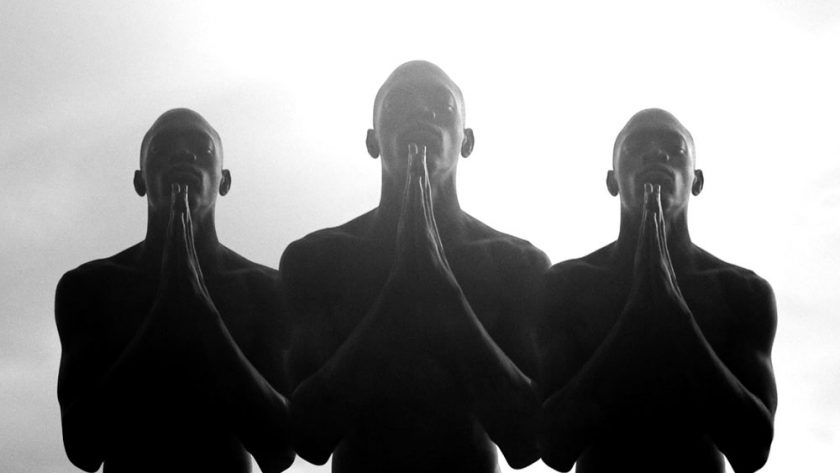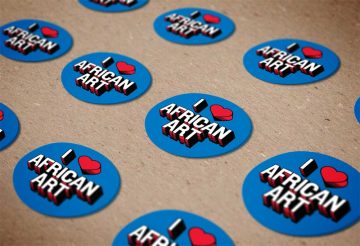The Smithsonian National Museum of African Art is the first institution to acquire the deeply personal and visually mesmerizing video projections Invocation: The Severance of Ties (2015) and Invocation: Release (2015) by versatile multimedia artist Jim Chuchu.
The careful negotiation between self-definition and societal expectations propel this two-part video work from the Nairobi-based artist. Chuchu is the central subject of both films. In Invocation: The Severance of Ties, Chuchu’s body spins and splits as he struggles to define himself in relation to history, country, and other universal human categories. The phrases “This is not your name” and “I am not your son” flash across the screen and are intoned rhythmically to the accompanying soundtrack composed by the artist. In Invocation: Release, the artist unfolds, exhales, and appears to accept the self he has become in the present and for the future. Both videos draw upon imagery from global religions, like Hinduism, as well as the transformational actions of initiation rites practiced by diverse communities across the vast African continent. The two films loop repeatedly, suggesting the continuous struggle of each new generation as they seek self-definition within the traditions and expectations into which they were born.
The exhibition Jim Chuchu’s Invocations is generously supported by Reggie Van Lee.
Jim Chuchu
b. 1982, Kenya
Invocation: The Severance of Ties
2015
Single-channel projection video
Museum purchase, 2017-1-1
Jim Chuchu
b. 1982, Kenya
Invocation: Release
2015
Single-channel projection video
Museum purchase, 2017-1-2
About the Artist

Chuchu helped establish the Nest Collective, a multidisciplinary art space and artists’ collective in Nairobi, in 2012. In 2013, he directed his first short film, Homecoming, which premiered at that year’s Durban International Film Festival and was featured throughout 2014 at the film festivals of Locarno, Rotterdam, Santa Barbara, Seattle, and Toronto. Chuchu’s photography series Pagans was highlighted, as part of the exhibition Precarious Imaging: Visibility and Media Surrounding African Queerness, at Dak’Art 2014, the 11th edition of Africa’s longest running biennial of contemporary art.1 Currently, the artist is working on music and a new film project.
To see more of Chuchu’s work, visit his website at jimchuchu.com.
A Blackness Not Afraid to Dream
Can you recall the moments that changed your life? Were rituals—such as a bris, naming ceremony, first communion, commencement, or wedding—a part of these junctures? Artist Jim Chuchu draws upon the language of rituals and the divine imagery of world religions to commemorate his journey to self-definition as an adult, and a gay man, and to envision a more inclusive African future.
During a public conversation with Seattle-based scholar Negarra A. Kudumu in 2015, Chuchu said he works across many mediums because he is “interested in artists like Khalil Joseph, and the move to reshape blackness . . . a blackness not afraid to dream, a blackness not afraid to exist in another world.”2 In the video projection suite Invocation: The Severance of Ties and Invocation: Release, Chuchu imagines a blackness accepting of multiple orientations and perspectives and an African future in which men and women feel free to control their own identities. To quote one reviewer, Chuchu’s work is “a hallucinatory cry of independence, as formally rigorous in its sounds and rhythms as it is beautiful.”3
Composed of two distinct videos looping in succession, the works together follow the structure of initiation rituals. In the first film, Invocation: The Severance of Ties, we see the artist’s body, his torso bare as he turns and lets the streamers in his hair catch the wind. Set to a soundtrack composed by the artist, phrases like “This is not your name” and “I am not your son” flicker across the screen as Chuchu’s form spins, splits, and morphs into a being that appears to wear a mask. Viewers are drawn into an entrancing montage of continuously shifting, fragmenting, and changing images depicting a state of being described by theorist and anthropologist Victor Turner as “betwixt and between”—the time when an initiate is neither the person he was before, nor the person he will become. In Invocation: Release, the artist’s figure unfolds, exhales vapor, and multiplies. He releases the past to become part of a new collective acceptance of who he is, now and for the future. Surrounded by Chuchu’s pulsing house beats and evocative imagery, viewers are invited to contemplate the separations and releases that shape our individual and community identities.
Politically charged, visually seductive, and technically sophisticated, these works of art are a legacy of our changing times and a tribute to the vision of their multifaceted creator.
Endnotes
1. Senegalese authorities shuttered the show less than a month after it opened, as well as ruling that all upcoming exhibitions addressing issues of homosexuality be cancelled.
2. Jen Graves, “Artist Jim Chuchu Visits Seattle, and Speaks about His Art, His Life, and Having His Film Banned by His Homeland,” The Stranger, May 22, 2015, http://www.thestranger.com/blogs/slog/2015/05/22/22264196/outlawed-in-his-own-country-kenyan-artist-jim-chuchu-comes-to-seattle, accessed March 20, 2017.
3. Michael Upchurch, “Many Stories in Jim Chuchu’s One-Man Show at Mariane Ibrahim Gallery,” The Seattle Times, May 29, 2015.

